Design of human-robot collaborative hybrid order picking
Gefördert von: Deutscher Akademischer Austauschdienst (DAAD)/Bundesministeriums für Bildung und Forschung (BMBF) Projektpartner: Prof. Dr. Tone Lerher, Faculty of Logistics an der Universität Maribor, Slowenien.
Publikationen
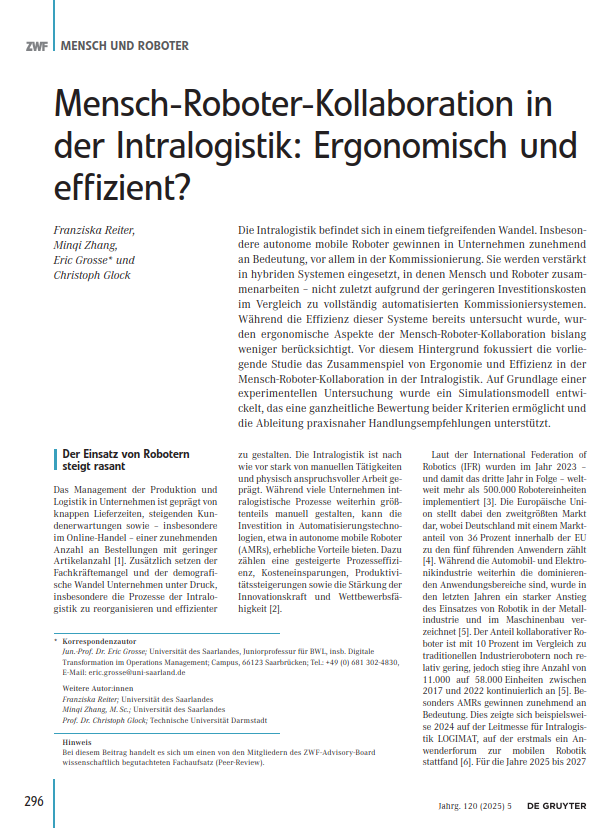
Mensch-Roboter-Kollaboration in der Intralogistik: Ergonomisch und effizient?
Reiter, Zhang, Grosse, Glock (2025)
Die Intralogistik befindet sich in einem tiefgreifenden Wandel. Insbesondere autonome mobile Roboter gewinnen in Unternehmen zunehmend an Bedeutung, vor allem in der Kommissionierung. Sie werden verstärkt in hybriden Systemen eingesetzt, in denen Mensch und Roboter zusammenarbeiten – nicht zuletzt aufgrund der geringeren Investitionskosten im Vergleich zu vollständig automatisierten Kommissioniersystemen. Während die Effizienz dieser Systeme bereits untersucht wurde, wurden ergonomische Aspekte der Mensch-Roboter-Kollaboration bislang weniger berücksichtigt. Vor diesem Hintergrund fokussiert die vorliegende Studie das Zusammenspiel von Ergonomie und Effizienz in der Mensch-Roboter-Kollaboration in der Intralogistik. Auf Grundlage einer experimentellen Untersuchung wurde ein Simulationsmodell entwickelt, das eine ganzheitliche Bewertung beider Kriterien ermöglicht und die Ableitung praxisnaher Handlungsempfehlungen unterstützt.
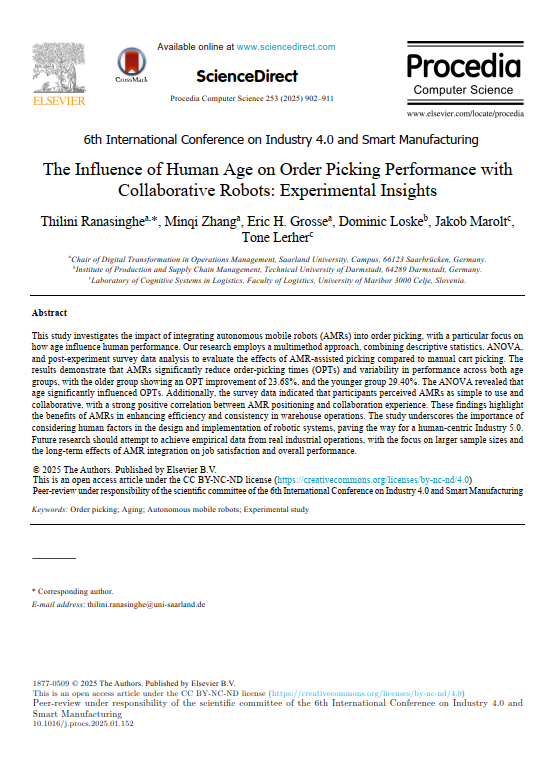
The Influence of Human Age on Order Picking Performance with Collaborative Robots: Experimental Insights
Ranasinghe, Zhang, Grosse, Loske, Marolt, Lerher (2025)
This study investigates the impact of integrating autonomous mobile robots (AMRs) into order picking, with a particular focus on how age influences human performance. Our research employs a multimethod approach, combining descriptive statistics, ANOVA, and post-experiment survey data analysis to evaluate the effects of AMR-assisted picking compared to manual cart picking. The results demonstrate that AMRs significantly reduce order-picking times (OPTs) and variability in performance across both age groups, with the older group showing an OPT improvement of 23.68%, and the younger group 29.40%. The ANOVA revealed that age significantly influenced OPTs. Additionally, the survey data indicated that participants perceived AMRs as simple to use and collaborative, with a strong positive correlation between AMR positioning and collaboration experience. These findings highlight the benefits of AMRs in enhancing efficiency and consistency in warehouse operations. The study underscores the importance of considering human factors in the design and implementation of robotic systems, paving the way for a human-centric Industry 5.0. Future research should attempt to achieve empirical data from real industrial operations, with a focus on larger sample sizes and the long-term effects of AMR integration on job satisfaction and overall performance.
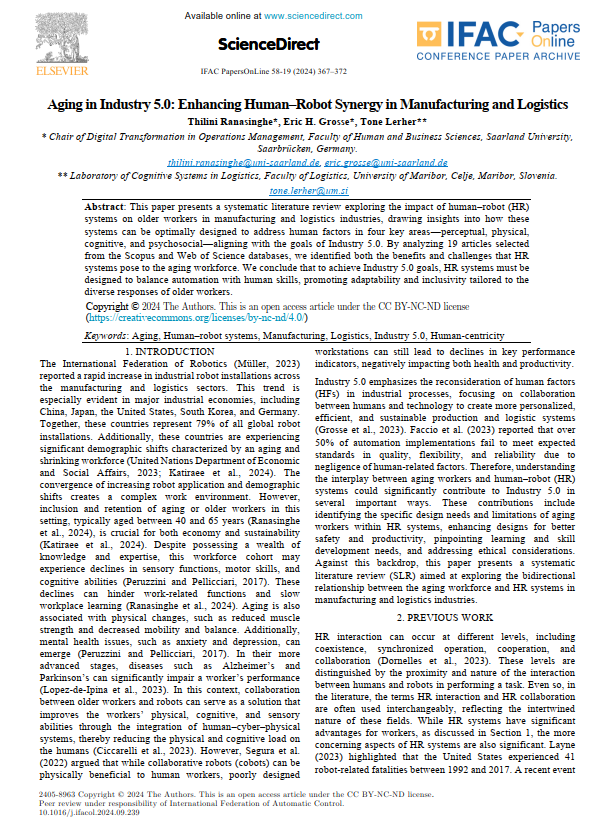
Aging in Industry 5.0: Enhancing Human–Robot Synergy in Manufacturing and Logistics
Ranasinghe, Grosse, Lerher (2024)
This paper presents a systematic literature review exploring the impact of human–robot (HR) systems on older workers in manufacturing and logistics industries, drawing insights into how these systems can be optimally designed to address human factors in four key areas—perceptual, physical, cognitive, and psychosocial—aligning with the goals of Industry 5.0. By analyzing 19 articles selected from the Scopus and Web of Science databases, we identified both the benefits and challenges that HR systems pose to the aging workforce. We conclude that to achieve Industry 5.0 goals, HR systems must be designed to balance automation with human skills, promoting adaptability and inclusivity tailored to the diverse responses of older workers.
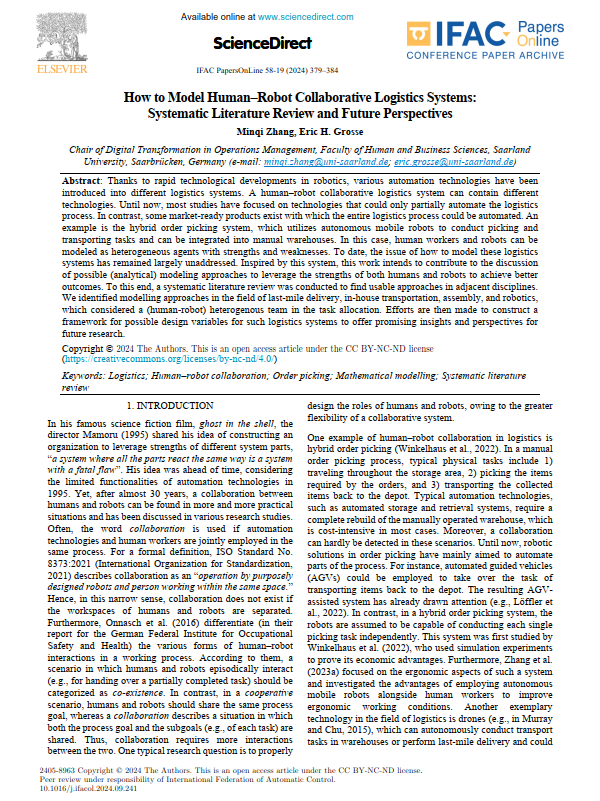
How to Model Human–Robot Collaborative Logistics Systems: Systematic Literature Review and Future Perspectives
Zhang, Grosse (2024)
Thanks to rapid technological developments in robotics, various automation technologies have been introduced into different logistics systems. A human–robot collaborative logistics system can contain different technologies. Until now, most studies have focused on technologies that could only partially automate the logistics process. In contrast, some market-ready products exist with which the entire logistics process could be automated. An example is the hybrid order picking system, which utilizes autonomous mobile robots to conduct picking and transporting tasks and can be integrated into manual warehouses. In this case, human workers and robots can be modeled as heterogeneous agents with strengths and weaknesses. To date, the issue of how to model these logistics systems has remained largely unaddressed. Inspired by this system, this work intends to contribute to the discussion of possible (analytical) modeling approaches to leverage the strengths of both humans and robots to achieve better outcomes. To this end, a systematic literature review was conducted to find usable approaches in adjacent disciplines. We identified modeling approaches in the field of last-mile delivery, in-house transportation, assembly, and robotics, which considered a (human-robot) heterogeneous team in the task allocation. Efforts are then made to construct a framework for possible design variables for such logistics systems to offer promising insights and perspectives for future research.
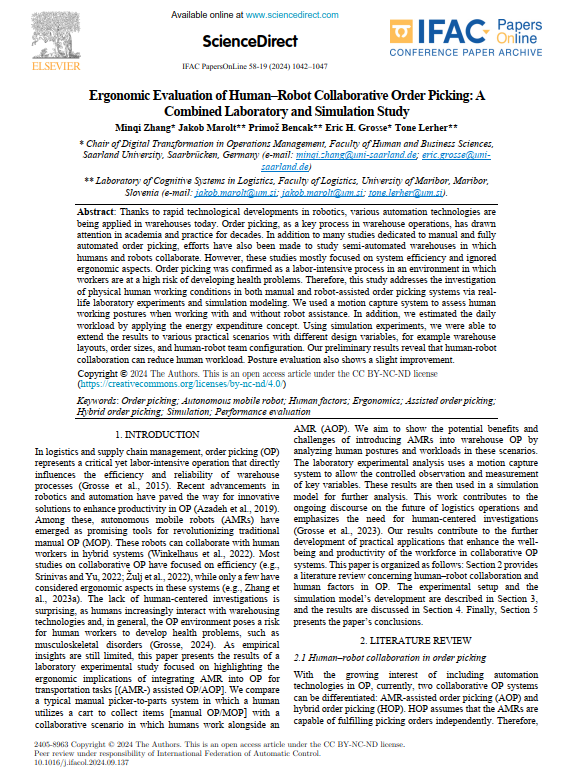
Ergonomic Evaluation of Human–Robot Collaborative Order Picking: A Combined Laboratory and Simulation Study
Zhang, Marolt, Bencak, Grosse, Lerher (2024)
Thanks to rapid technological developments in robotics, various automation technologies are being applied in warehouses today. Order picking, as a key process in warehouse operations, has drawn attention in academia and practice for decades. In addition to many studies dedicated to manual and fully automated order picking, efforts have also been made to study semi-automated warehouses in which humans and robots collaborate. However, these studies mostly focused on system efficiency and ignored ergonomic aspects. Order picking was confirmed as a labor-intensive process in an environment in which workers are at a high risk of developing health problems. Therefore, this study addresses the investigation of physical human working conditions in both manual and robot-assisted order picking systems via real-life laboratory experiments and simulation modeling. We used a motion capture system to assess human working postures when working with and without robot assistance. In addition, we estimated the daily workload by applying the energy expenditure concept. Using simulation experiments, we were able to extend the results to various practical scenarios with different design variables, for example warehouse layouts, order sizes, and human-robot team configuration. Our preliminary results reveal that human-robot collaboration can reduce human workload. Posture evaluation also shows a slight improvement.
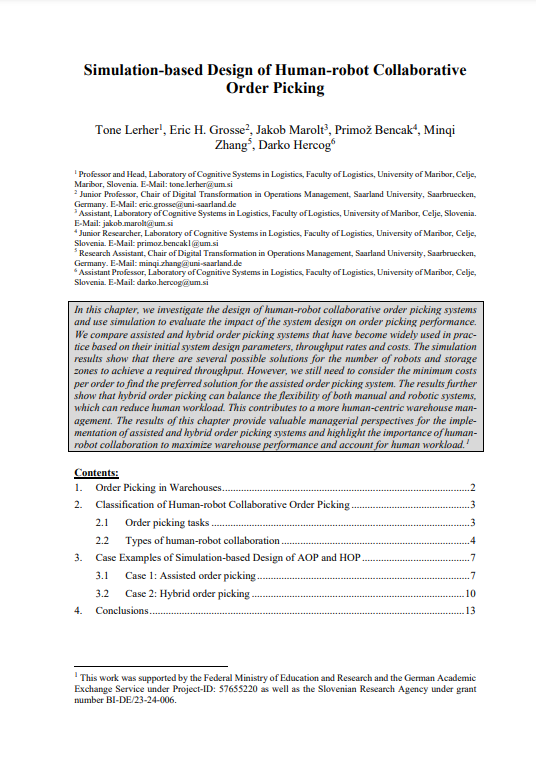
Simulation-based Design of Human-robot Collaborative Order Picking
Lerher, Grosse, Marolt, Bencak, Zhang & Hercog (2024)
In this chapter, we investigate the design of human-robot collaborative order picking systems and use simulation to evaluate the impact of the system design on order picking performance. We compare assisted and hybrid order picking systems that have become widely used in practice based on their initial system design parameters, throughput rates and costs. The simulation results show that there are several possible solutions for the number of robots and storage zones to achieve a required throughput. However, we still need to consider the minimum costs per order to find the preferred solution for the assisted order picking system. The results further show that hybrid order picking can balance the flexibility of both manual and robotic systems, which can reduce human workload. This contributes to a more human-centric warehouse management. The results of this chapter provide valuable managerial perspectives for the implementation of assisted and hybrid order picking systems and highlight the importance of humanrobot collaboration to maximize warehouse performance and account for human workload.

Mensch-Roboter-Zusammenarbeit in der Intralogistik: Vorteile und Auswirkungen auf die Beschäftigten
Zhang , Ludwig, Grosse (2023)
Die Kommissionierung ist eine besonders zeit- und kostenintensive Tätigkeit in der Intralogistik, vor allem wenn diese manuell ausgeführt wird. Deswegen kann es für Unternehmen wirtschaftlich interessant sein, autonome Kommissionierroboter, die mit Menschen zusammenarbeiten, in einem hybriden System einzusetzen. Dieser Artikel gibt einen Überblick über die Vorteile der Mensch-Roboter-Zusammenarbeit in der Intralogistik und quantifiziert diese exemplarisch mit Hilfe eines Simulationsmodells. Daneben werden praxisnahe Herausforderungen bei der Implementierung derartiger hybrider Systeme in Bezug auf Menschenzentrierung, Ergonomie, Technologie-Akzeptanz und wirtschaftliche Arbeitsleistung im Sinne der Industrie 5.0 beleuchtet.

